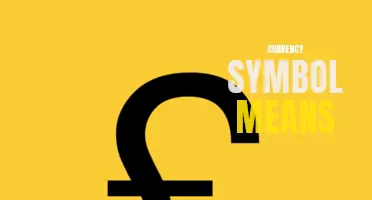
Status symbols have long been a part of human society, serving as outward signs of success, wealth, and social standing. From luxury cars and designer clothing to elaborate homes and fine jewelry, these symbols not only serve to impress others but also to reinforce one's own self-worth. But what is the true meaning behind these status symbols? Are they simply material possessions meant to flaunt one's wealth, or do they hold a deeper significance that goes beyond their monetary value? In this article, we will explore the multifaceted meaning of status symbols and their role in shaping our perception of success and happiness.
What You'll Learn
- What is the meaning of a status symbol and how does it differ from other forms of symbolism?
- How have status symbols evolved throughout history, and what are some common examples of status symbols in modern society?
- Does the interpretation of status symbols vary between different cultures or socioeconomic groups?
- How does the acquisition or display of status symbols impact an individual's self-esteem and overall social standing?
- Are there any potential negative effects of status symbols, such as fostering materialism or perpetuating inequality?

What is the meaning of a status symbol and how does it differ from other forms of symbolism?
Status Symbol: Its Meaning and Difference from Other Forms of Symbolism
A symbol is an object, gesture, or word that represents something beyond its literal meaning. It serves as a way of communication, conveying ideas, values, and concepts. Symbolism can be found in various aspects of life, ranging from literature and art to social dynamics and cultural practices. One particular type of symbolism that holds immense significance in society is a status symbol.
A status symbol refers to an object, possession, or characteristic that a person uses to display their social or economic status. It serves as a visible indicator of a person's position in society, showcasing their power, wealth, and influence. Status symbols can vary from country to country, culture to culture, and even within different social classes. For some, owning a luxurious car or wearing designer clothes may be a representation of high social status, while for others, it could be living in a particular neighborhood or having a prestigious job.
What sets status symbols apart from other forms of symbolism is their association with social hierarchy and material wealth. While symbols in general can represent a wide range of concepts, status symbols specifically focus on the display of one's standing in society. Obtaining and displaying status symbols can be seen as a way of asserting dominance, garnering respect, and elevating one's social position. It has both psychological and social implications, as people often strive to acquire these symbols to enhance their self-image and gain recognition from others.
Status symbols can take various forms depending on the prevailing values and cultural norms of a society. In some cultures, wearing expensive jewelry or carrying luxury accessories may be considered prestigious, while in others, it could be owning a large house or having a particular job title. The significance and meaning of status symbols are subjective and influenced by factors such as cultural background, economic conditions, and prevailing social norms.
It is essential to differentiate status symbols from other forms of symbolism such as religious symbols, national symbols, or artistic symbols. While status symbols are primarily concerned with social standing, other types of symbols serve different purposes. Religious symbols, for instance, convey spiritual or metaphysical concepts and guide individuals' beliefs and practices. National symbols represent a country's identity and values, fostering a sense of collective belonging and patriotism. Artistic symbols, on the other hand, express emotions, ideas, and aesthetics, aiming to evoke personal interpretations and stimulate creativity.
In conclusion, a status symbol is a form of symbolism that represents a person's social or economic standing. It differs from other forms of symbolism due to its association with material wealth and social hierarchy. Status symbols come in various forms and are influenced by cultural norms and values. They serve as visible indicators of social status, allowing individuals to display their power, wealth, and influence. Understanding the meaning of status symbols helps shed light on the dynamics of social interactions and the significance people attach to material possessions.
Decoding the Symbols on the BMW E90 Fuse Box: What Do They Mean?
You may want to see also

How have status symbols evolved throughout history, and what are some common examples of status symbols in modern society?
Status symbols have played a prominent role in societies throughout history. These symbols are used to denote a person's social standing and often reflect their wealth, power, or influence. While the specific indicators of status have changed over time, the concept of status symbols remains prevalent in modern society.
In ancient civilizations, status symbols were often associated with material possessions. For example, in ancient Egypt, wearing elaborate jewelry made from precious metals and gemstones was a sign of wealth and social standing. Similarly, in ancient Rome, owning large estates, fine clothing, and chariots were indicators of a person's high status.
During the Middle Ages, status symbols shifted towards land ownership and titles. Nobles and royalty displayed their status through grand castles and palaces, as well as intricate coats of arms. These symbols not only represented their wealth but also their ancestral heritage and power.
The Renaissance period introduced a new form of status symbols - art and culture. Wealthy individuals displayed their status through patronage of artists and collectors of fine art. Possessing rare and valuable artworks became a way to showcase one's refined taste and sophistication.
With the rise of industrialization and capitalism in the 19th century, status symbols started to become more accessible to the middle class. The industrial revolution created a new class of wealthy industrialists and entrepreneurs. These individuals displayed their status through lavish mansions, luxurious carriages, and extravagant parties. Owning these symbols of wealth became aspirational for many people, leading to the birth of consumer culture.
In the 20th century, as society became more egalitarian, status symbols took on new forms. Alongside traditional indicators of wealth, social status started to be associated with education, occupation, and lifestyle choices. For example, owning a prestigious degree, driving a luxury car, or wearing designer clothing became symbols of success and social standing.
In modern society, status symbols continue to evolve. Technology has become a new realm for status markers. Owning the latest smartphone or driving a luxury electric car has become a way of signaling social and technological sophistication. Social media platforms have also transformed into virtual status symbols, with the number of followers and likes becoming indicators of popularity and influence.
Moreover, experiences and travel have become status symbols. Posting pictures from exotic locations or attending exclusive events has become a way for people to showcase their adventurous lifestyles. In the age of Instagram, documenting one's travels through carefully curated photos has become a form of visual status display.
Despite the changing landscape of status symbols, their underlying purpose remains the same. They serve as a means of social differentiation, allowing individuals to communicate their social status and aspirations. While the specific symbols may change over time, the human desire for recognition and admiration remains a constant driving force behind the evolution of status symbols.
The Intriguing Meanings Behind Magic: The Gathering Symbols Revealed
You may want to see also

Does the interpretation of status symbols vary between different cultures or socioeconomic groups?
Status symbols, such as luxury cars, designer clothing, and large houses, are often used to convey one's social and economic standing. However, the interpretation of these symbols can vary significantly between different cultures and socioeconomic groups.
In many Western societies, possessing material possessions is often seen as a sign of success and social status. People who are able to afford expensive items are often admired and looked up to. Luxury brands are seen as a way to distinguish oneself and signal wealth. In this context, status symbols are often associated with prestige and power.
However, in other cultures, the interpretation of status symbols may differ significantly. For example, in certain Asian cultures, such as Japan and China, modesty and understatement are highly valued. Instead of flashy displays of wealth, people may prioritize subtler signs of status, such as education, intellectual pursuits, and social connections. In these societies, intelligence and knowledge are often considered more important markers of success than material possessions.
Socioeconomic groups within a society can also shape the interpretation of status symbols. The wealthy upper class might have different symbols of status compared to the middle class or the working class. For example, while the upper class might value expensive jewelry and exclusive memberships, the middle class might seek out affordable luxury items or focus on experiences such as travel. The working class, on the other hand, might view things like a stable job, financial security, and access to healthcare as indicators of status.
Furthermore, the interpretation of status symbols can also change over time. What may have been considered a status symbol in the past might no longer hold the same significance today. For example, owning a large, gas-guzzling SUV might have been seen as a symbol of success a few decades ago, but in today's environmentally conscious society, it could be viewed negatively as a symbol of excess and disregard for the planet.
It is essential to consider these variations in the interpretation of status symbols when studying culture and social hierarchies. Judging someone's status solely based on their possessions can lead to misconceptions and misunderstandings. It is important to recognize that different cultures and socioeconomic groups have their own unique values and belief systems, which influence how they interpret and display status in their respective societies.
In conclusion, the interpretation of status symbols can vary greatly between different cultures and socioeconomic groups. While material possessions might be highly valued in some societies, others may prioritize intellectual pursuits, education, or social connections as indicators of status. Additionally, within a single society, different socioeconomic groups may have their own distinct symbols of status. It is crucial to recognize and respect these variations to better understand the complexities of societal norms and values.
The Symbolic Meanings and Origins of the Claddagh Symbol
You may want to see also

How does the acquisition or display of status symbols impact an individual's self-esteem and overall social standing?
Status symbols, such as luxury cars, designer clothes, and expensive jewelry, have long been used as a way for individuals to display their wealth and social status. These symbols can have a profound impact on an individual's self-esteem and overall social standing.
For many people, acquiring status symbols serves as a form of validation and recognition. It reinforces their sense of self-worth and boosts their self-esteem. When they are able to obtain and display these symbols, they feel a sense of accomplishment and superiority. It becomes a way to show off their success and affluence to others.
The acquisition of status symbols also plays a crucial role in shaping an individual's social standing. In many societies, wealth and material possessions are often equated with power and prestige. Those who possess status symbols are often seen as more influential and desirable. They are more likely to be included in social circles and have access to exclusive events and opportunities.
Additionally, the display of status symbols can create a sense of envy and admiration from others. People may look up to those who possess these symbols and aspire to achieve similar levels of success. This admiration can further elevate an individual's social standing and provide them with a sense of superiority over others.
However, it is important to note that the impact of status symbols on an individual's self-esteem and social standing can be both positive and negative. While some may find validation and confidence in acquiring these symbols, others may feel inadequate or inferior if they are unable to attain them. They may struggle with feelings of envy and low self-worth, which can negatively affect their mental well-being and relationships with others.
Furthermore, relying too heavily on status symbols to define one's self-worth and social standing can be problematic. It can lead to a shallow and materialistic worldview, where a person's value is solely determined by their possessions. This can hinder personal growth and prevent individuals from seeking genuine connections and meaningful experiences.
In conclusion, the acquisition and display of status symbols can significantly impact an individual's self-esteem and overall social standing. They can provide validation and recognition, elevate social status, and create a sense of admiration from others. However, it is important to approach these symbols with caution and recognize their limitations in defining one's self-worth. True happiness and fulfillment come from cultivating genuine relationships and personal growth, rather than relying solely on material possessions.
Decoding the Symbolism behind Greta Van Fleet: An Insight into Their Meaningful Imagery
You may want to see also

Are there any potential negative effects of status symbols, such as fostering materialism or perpetuating inequality?
Status symbols have long been a part of human culture, representing wealth, power, and prestige. From luxurious cars and designer clothes to expensive homes and lavish vacations, status symbols are often seen as a reflection of one's social standing and success. However, while these symbols may be coveted by many, they also have the potential to create negative effects on both individuals and society as a whole.
One of the main concerns with status symbols is that they can foster materialism, leading individuals to prioritize the accumulation of material possessions over other aspects of life. This can create a never-ending cycle of desire, where people constantly strive for the next big thing in order to maintain their status. In doing so, individuals may neglect more meaningful pursuits, such as personal relationships, mental well-being, and experiences that bring genuine happiness. This hyper-focus on materialism can lead to a sense of emptiness and dissatisfaction, as the pursuit of status symbols fails to bring true fulfillment.
Furthermore, status symbols can perpetuate inequality within society. They act as visible markers of social hierarchy, reinforcing the divide between the haves and the have-nots. Those who can afford these symbols benefit from the recognition and respect they receive, while those who cannot afford them feel marginalized and excluded. This can exacerbate social stratification and widen the wealth gap, as individuals strive to attain status symbols to gain social acceptance and elevate their perceived status. As a result, the pursuit of status symbols can contribute to the perpetuation of an unequal society.
Moreover, status symbols can also contribute to environmental degradation. The production and consumption of luxury goods, such as high-end fashion or exotic cars, often come at a significant cost to the environment. The extraction of raw materials, the manufacturing process, and the disposal of these goods contribute to resource depletion, excessive waste, and pollution. In a world already grappling with climate change and environmental crisis, the glorification and pursuit of status symbols only further exacerbate these pressing issues.
It is important to note that not all individuals are swayed by status symbols, and some people may genuinely appreciate the quality or craftsmanship of luxury goods. However, it is crucial to recognize the potential negative effects that status symbols can have on individuals and society as a whole. Encouraging a shift in values away from materialism and towards more meaningful pursuits, such as personal growth, social connections, and sustainable living, can help mitigate these negative effects.
In conclusion, while status symbols may be desired and admired by many, they also have the potential to foster materialism, perpetuate inequality, and contribute to environmental degradation. Recognizing the damaging effects of status symbols and promoting alternative values can help create a more balanced and equitable society where individuals can find true fulfillment beyond the pursuit of material possessions.
Decoding the Hidden Meanings Behind Instagram Story Symbols
You may want to see also
Frequently asked questions
A status symbol is an object or characteristic that is used to signify a person's social or economic standing in society. It serves as a way for individuals to demonstrate their success, wealth, or importance to others.
Common examples of status symbols include luxury cars, designer clothing, expensive jewelry, and large houses. These items are often associated with wealth and are seen as indicators of a high social standing.
People use status symbols for a variety of reasons. For some, it is a way to gain recognition and admiration from others. For others, it may be a way to fit in with a certain social group or to feel a sense of achievement and success.
Yes, status symbols can vary across different cultures and societies. What may be considered a status symbol in one culture may hold little importance in another. For example, in some cultures, owning a large amount of land may be seen as a status symbol, while in others, it may be owning a specific brand of luxury goods.
While many status symbols are material possessions, such as expensive cars or designer clothing, status can also be conveyed through non-material means. For example, a prestigious job title, advanced degrees, or influential connections can also be considered status symbols. It ultimately depends on the values and priorities of a particular society or social group.







